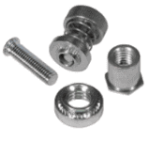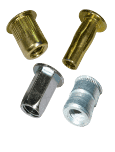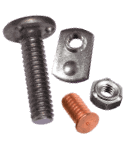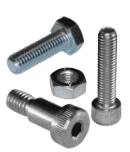Spacers and Standoffs
February 07, 2024
In the intricate world of industrial and electronics assemblies, spacers and standoffs are essential yet often understated components. These small but crucial pieces play a vital role in ensuring the proper spacing and alignment of parts, contributing to the overall integrity and functionality of various applications.
Spacers and standoffs are types of fasteners that create precise distances between two components. Standoffs, typically cylindrical or hexagonal and threaded, allow for the attachment of parts at a set distance, often used in electronic assemblies to prevent short circuits. Spacers, usually unthreaded, and cylindrical or hexagonal, maintain a fixed space between components, commonly seen in machinery and structural applications.
These components find extensive use across various industries. In electronics, they prevent contact between circuit boards and conductive surfaces. In construction, they aid in aligning structural elements accurately. In machinery, they ensure the correct positioning of moving parts, preventing wear, and improving efficiency.
When selecting spacers and standoffs, consider the following:
Sometimes, off-the-shelf spacers and standoffs may not meet specific requirements. In such cases, custom-made solutions can be sought. Moreover, it’s important to adhere to industry standards and specifications to ensure compatibility and safety.
In conclusion, the careful selection of spacers and standoffs is crucial in a wide range of industrial applications. By considering factors such as material, size, load capacity, and environmental conditions, you can ensure that the selected components meet the demands of your specific application. Whether for electronic circuitry or heavy machinery, the right choice of spacers and standoffs can significantly impact the performance and longevity of your equipment. Remember, these small components, though often overlooked, are fundamental in maintaining the integrity and functionality of larger systems.
It can often be difficult to choose the right standoff or spacer. With the nearly endless material types, plating options, thread sizes and body sizes/lengths, it can be difficult to assess the application's specific requirements. We have experts on staff that have several lifetimes of experience in this arena, and we would be happy to take the time to walk through this process with you and help you determine the correct standoff or spacer for your application.
In the intricate world of industrial and electronics assemblies, spacers and standoffs are essential yet often understated components. These small but crucial pieces play a vital role in ensuring the proper spacing and alignment of parts, contributing to the overall integrity and functionality of various applications.
Understanding Spacers and Standoffs
Spacers and standoffs are types of fasteners that create precise distances between two components. Standoffs, typically cylindrical or hexagonal and threaded, allow for the attachment of parts at a set distance, often used in electronic assemblies to prevent short circuits. Spacers, usually unthreaded, and cylindrical or hexagonal, maintain a fixed space between components, commonly seen in machinery and structural applications.
Industrial Applications of Spacers and Standoffs
These components find extensive use across various industries. In electronics, they prevent contact between circuit boards and conductive surfaces. In construction, they aid in aligning structural elements accurately. In machinery, they ensure the correct positioning of moving parts, preventing wear, and improving efficiency.
Key Factors in Selection
When selecting spacers and standoffs, consider the following:
- Material: Choose based on environmental exposure and mechanical requirements. Options include metals like stainless steel for strength and corrosion resistance, and plastics for electrical insulation. The material and plating options are almost limitless. If the material can be machined it can generally be used for this type of fastener.
- Size and Dimensions: Ensure compatibility with the components being used. This includes length, diameter, and thread specifications for standoffs.
- Load Capacity: Consider the weight and mechanical forces the standoff or spacer must withstand. Heavier loads may require more robust materials or specific designs.
- Environmental Conditions: For harsh conditions, select materials (or a plating) that resists corrosion, temperature extremes, and chemical exposure.
Customization and Standards
Sometimes, off-the-shelf spacers and standoffs may not meet specific requirements. In such cases, custom-made solutions can be sought. Moreover, it’s important to adhere to industry standards and specifications to ensure compatibility and safety.
Conclusion
In conclusion, the careful selection of spacers and standoffs is crucial in a wide range of industrial applications. By considering factors such as material, size, load capacity, and environmental conditions, you can ensure that the selected components meet the demands of your specific application. Whether for electronic circuitry or heavy machinery, the right choice of spacers and standoffs can significantly impact the performance and longevity of your equipment. Remember, these small components, though often overlooked, are fundamental in maintaining the integrity and functionality of larger systems.It can often be difficult to choose the right standoff or spacer. With the nearly endless material types, plating options, thread sizes and body sizes/lengths, it can be difficult to assess the application's specific requirements. We have experts on staff that have several lifetimes of experience in this arena, and we would be happy to take the time to walk through this process with you and help you determine the correct standoff or spacer for your application.










